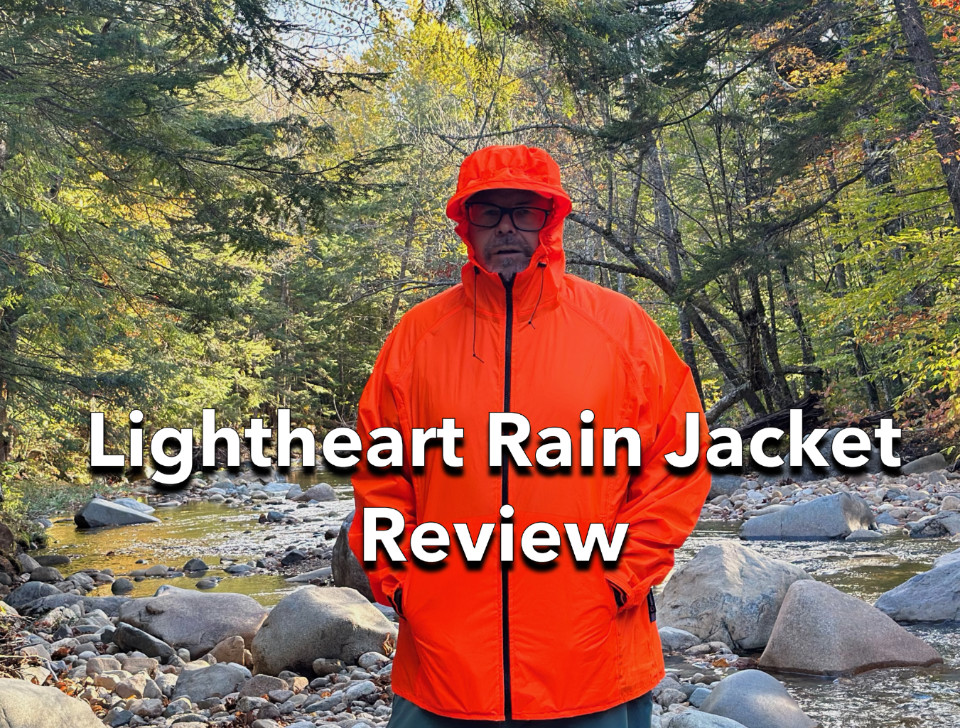 The LightHeart Gear Rain Jacket (MSRP $150) is a lightweight siliconized polyester (silpoly) waterproof rain jacket made the old-fashioned way, without any so-called waterproof/breathable fabric. Coated on the outside with silicone and on the inside with polyurethane (PU), this maintenance-free rain jacket won’t wet out like much more expensive waterproof breathable jackets that are coated with Durable Water Repellant (DWR) and need to be periodically reproofed to repel rain. (See: Why does Waterproof/Breathable Rain Gear Wet Out?)
The LightHeart Gear Rain Jacket (MSRP $150) is a lightweight siliconized polyester (silpoly) waterproof rain jacket made the old-fashioned way, without any so-called waterproof/breathable fabric. Coated on the outside with silicone and on the inside with polyurethane (PU), this maintenance-free rain jacket won’t wet out like much more expensive waterproof breathable jackets that are coated with Durable Water Repellant (DWR) and need to be periodically reproofed to repel rain. (See: Why does Waterproof/Breathable Rain Gear Wet Out?)
I’ve been a longtime fan of this jacket which Lightheart Gear has repeatedly improved over the years. In this latest iteration, they’ve taped the seams so they won’t leak in heavy rain and they now use waterproof zippers on the front zipper and along the pit zips. Made in the USA, this is a highly functional rain jacket that is designed by people who hike and backpack and know first-hand what hikers need to hike in the rain. You really can’t say that about most of the other rain jackets and hard shells available today.
Specs at a Glance
- Best use: Hiking, Backpacking, Everyday
- Weight: 6.4 oz in a men’s size Large (women’s also available)
- Hydrostatic head: 3000 mm (better than most tents)
- Fabrics: 20D ripstop polyester, silicone-coated on the outside, PU-coated on the inside
- Seams: Taped
- Pit zips: Yes, 20″ long
- Waterproof Zippers: Yes
- Pockets: 4
- Breathable: No
- Sizing: Generous to permit layering
- Colors: Many, including blaze orange which is good for hunting season and off-trail use
- Origin: Made in the USA
Rain Jacket Features
Weighing just 6.4 ounces in a men’s size L, the LightHeart Gear Rain Jacket is fully featured with many of the bells and whistles you’d find on much more expensive jackets. This includes an adjustable hood with neck cords and a front brim, dual front handwarmer pockets, two internal drop pockets that you can stuff the jacket into, adjustable wrist cuffs, and 20″ long pit zips that run below the biceps and down the torso to vest excess heat.
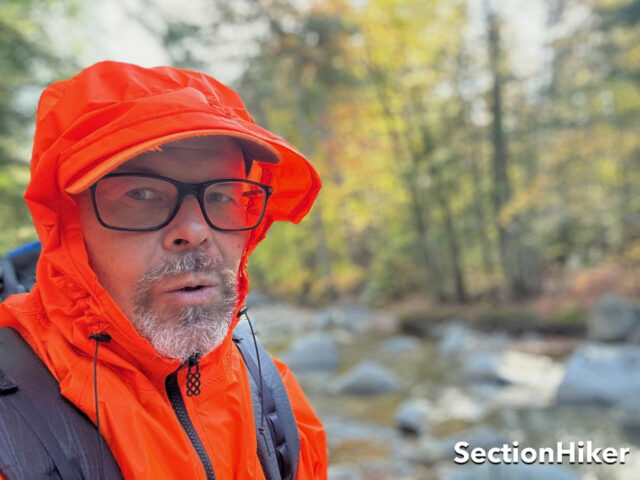
Adjustable Hood
The hood can be cinched tightly around your head to prevent wind, rain, and cold from blowing in and chilling you. I’ve never understood why rain jacket manufacturers don’t provide full hood controls to help trap the heat around your head or why hikers buy jackets with oversized helmet-compatible hoods that can’t be cinched closed. The hood brim on the jacket can prevent rain from dripping down onto your face or glasses when it’s drawn tight, but it is also compatible with wide-brimmed and billed hats. The hood is also large enough that you can wear it over a climbing or cycling helmet.

Pockets
The front hand warmer pockets are not zippered. I can usually get my hands into them to grab something when I’m wearing a backpack, but it depends on how padded the hip belt is. I’d love to see two zippered chest pockets added to the jacket instead, but that would probably make the jacket more expensive to buy. The jacket also has two deep internal drop pockets that are open at the top and which can be used to stash gloves or snacks. You can also stuff the jacket into one of them for storage although the jacket comes with a stuff sack as well.
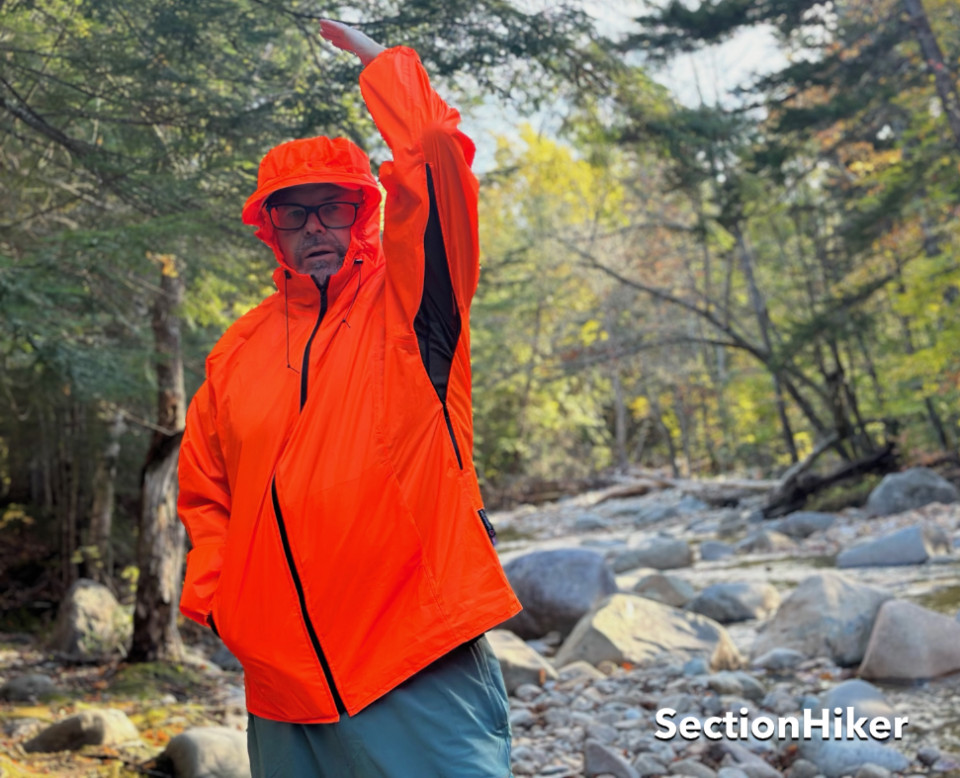
Pit Zips
There are 20″ pit zips that run down the biceps and down the sides of the jacket to help vent extra warmth and reduce your perspiration rate. The cool thing about these long pit zips is that you can also stick your arms through the pit zips and wear the jacket like a vest. This sheds a lot more heat than the pit zips alone when hiking, especially in warmer weather where you want some evaporative cooling from the surface of your skin to reduce the amount of heat buildup inside the jacket. I’ve found this to be very effective.
Wrist Cuffs
The rain jacket has elastic wrist cuffs with velcro (hook and loop) tabs so you can seal them closed. This is helpful if you wear rain mittens and want to close off the jacket-to-mitten interface to stay warmer or to prevent rain from dripping down your jacket sleeves. Your blood flows close to the surface of your wrists, so keeping them warm is important in cold weather.
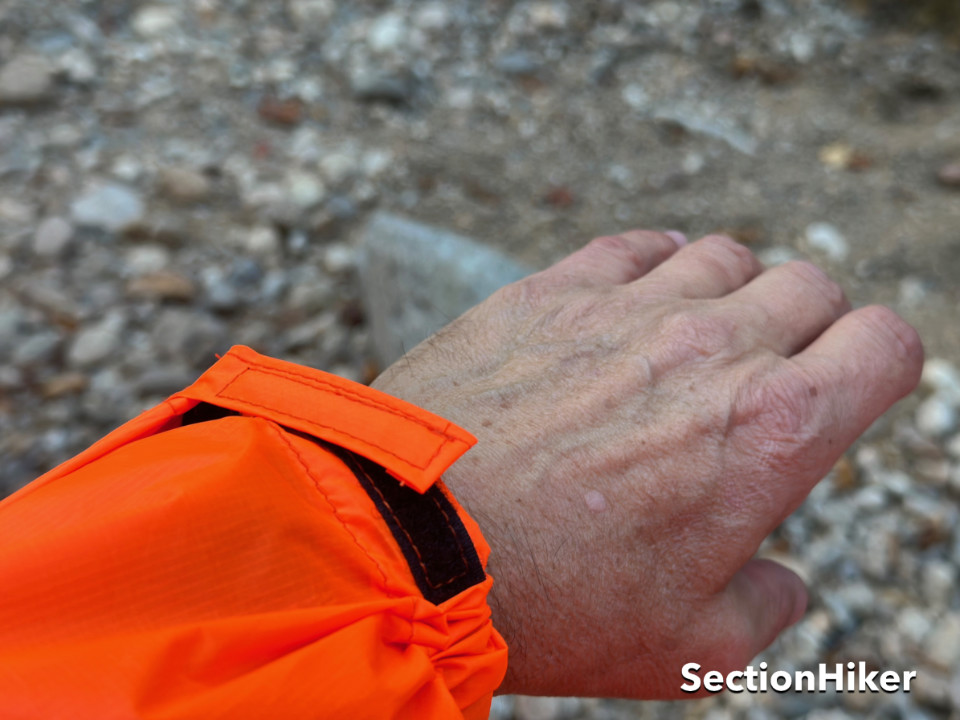
Waterproof Zippers
All of the zippers on the Lightheart Geat Rain Jacket, including the front zipper and the pit zips, are now waterproof. This is a major upgrade. The flap of fabric that protected the front zipper on the previous version and was the cause of many zipper jams has also been removed.
Warmth Not Dryness
When water hits the surface of the LightHeart Rain jacket, it beads up and rolls off as you’d expect, rather than soaking the fabric and chilling you. The fact that the LightHeart Rain Jacket is coated in silicone and polyurethane, means that you never have to worry about a DWR coating wearing off or having this jacket wet-out where the outer fabric gets soaked with water, the most common point of failure for rain jackets made using waterproof-breathable fabrics.
But there’s no denying the fact that this jacket retains a lot of heat when you’re active. While that’s a good thing in cold rainy weather, you need to be proactive when it comes to venting the jacket if you start to overheat and perspire. The long pit-zips facilitate this as does sticking your arms out through the pit-zip holes, like a vest, for even more ventilation.
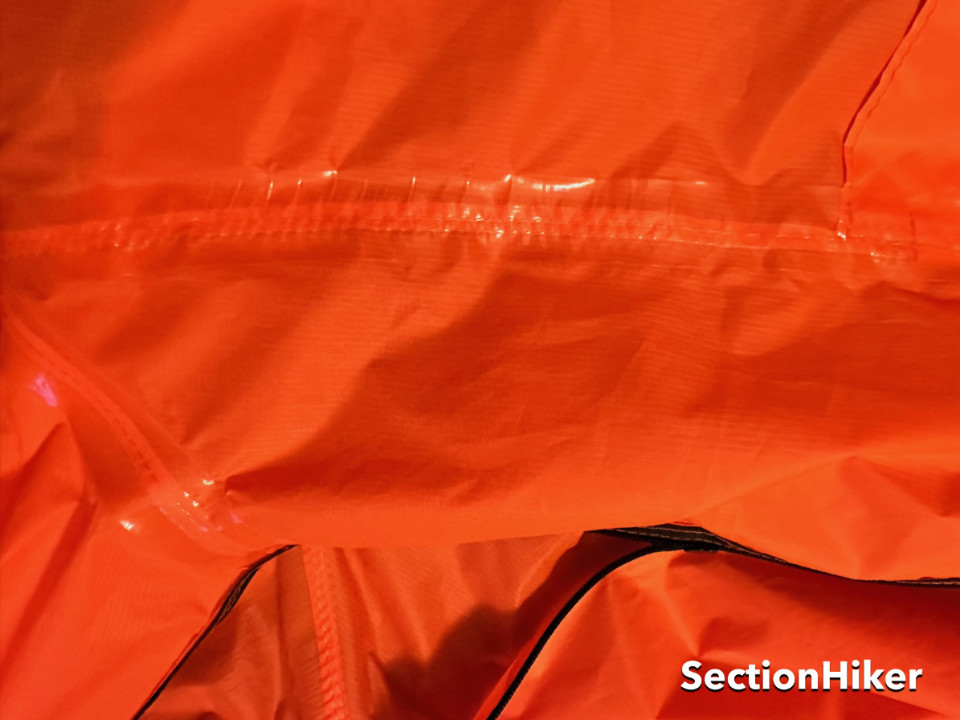
But there’s an underlying philosophy behind this jacket’s design that I haven’t touched on yet that’s important to discuss. That is, that it’s more important to stay warm and prevent hypothermia when you’re hiking in the rain than to stay dry. My view is that there’s a big difference between sweating on the inside, where it’s warm, and getting soaked from the outside, where your body heat can’t offset the cooling effect of a garment that’s been soaked by wet-out. That’s the advantage of wearing the LightHeart Gear Rain Jacket, which is permanently waterproof. The rain jacket acts as a thermal barrier to prevent uncontrollable heat loss but still has temperature regulation features like pit zips to help you regulate the degree of interior warmth and perspiration you prefer.
LightHeart Gear Rain Jacket
Water Resistance
Breathability
Comfort & Mobility
Hood Adjustability
Weight
Durability
Packed Size
Made for Backpacking by Backpackers
Recommendation
If you’re like me and sick of waterproof-breathable rain jackets that don’t live up to expectations, I suggest you give the LightHeart Gear Rain Jacket a try. It will probably be the last backpacking rain jacket you ever need to buy.
Disclosure: LightHeart Gear donated a jacket for review.
SectionHiker is reader-supported. We only make money if you purchase a product through our affiliate links. Help us continue to test and write unsponsored and independent gear reviews, beginner FAQs, and free hiking guides. SectionHiker.com Backpacking Gear Reviews and FAQs
SectionHiker.com Backpacking Gear Reviews and FAQs
I got this jacket a few years ago on your recommendation and have been very happy with it. One of the benefits of not wetting out is that you can still wear it as a layer in camp after hiking in the rain. I wipe the sweat from inside with a camp towel, then wear it over dry clothes. You can’t do that with a soaked waterproof/breathable jacket.
Just received my LHG Rain Jacket. Looks great! Mine came seam sealed (early April 2023). I emailed them to see why. A quick response from them stated that they are “in the process of transitioning to all taped seams” and the “price is going to reflect it soon!” Lucky me – taped seams at the original price!
For those interested in sizing, I’m 6-2, 188 lbs with longish arms (36″). The large fits great; the arms are just long enough. 1″ longer would have been better but not worth the $75 for a custom sleeve length.
They just (as of 6/1/23) put the version reviewed here on clearance, and have a “new” version that’s now seam taped with waterproof zippers for $25 more ($40 more than the clearance price). It no longer has the flap to cover the main zipper, but appears to be the same jacket otherwise.
My LHG rain coat had no room to put in a waist band, so I returned it and asked them (LHG) to “cherry pick” one that had enough clearance for a waist band, which they did and thenthey installed a waist band.
Thanks for the review. Want to rplc my O.R. jacket which has several great features but inadequate rain protection. One question about this Lightheart Gear jacket. Front pockets have no zippers it seems. Won’t rain just pour down inside them?
My husband and I both have one of her jackets. I have hips and this is wide enough for mine.
It now has seam tape on each seam and a waterproof zipper, which should resolve the leaky issues you had.
How is the durability under a pack? Appreciate the thorough review!
I’ve been using LHG rain jackets for years and never had any of the issue with shoulder strap abrasion that you get with waterproof/breathable rain jackets coated with dwr. The fabric is super slippery. I wouldn’t worry about it.
Nice review; I think I’ll give it a try.
In my experience waterproof/breathable jackets are neither.
I think the taping of seams was a desperately needed move to possibly make this a viable piece of gear. I’ve owned the jacket and pants for several years and honestly was disappointed with the jacket. I’d get wet before I sweat in any rain. I tried even using seam sealer but no banana. I’m glad it’s worked for some of you, but I couldn’t count on it so had to move on. Will be trying the sea to summit poncho this go around for first time.
I like these jackets, I’ll be looking at purchasing one in the future. Other manufacturers should make pit zips as nice as these…..
When it comes to non-breathable rain jackets….this one, or the Warbonnet Stash?
You need to decide if the additional features on the LHG jacket are worth the extra cost.
I got one many years ago based on your first review, never even realized the zipper wasn’t waterproof. I guess it’s been that effective for me, but the upgrade removing the long flap looks appealing. I do still want some sort of zippered front pocket because I’ve had stuff fall out of the pockets.
FWIW, with the upgrades for the new model the increased from $125 to $150.
I bought this rain jacket after an earlier review comparing DWR and several syl-poly rain jackets. I called the LionHeart people to discuss sizing and whether or not to shorten the sleeves. I bought a women’s small in magenta. Their advice was that the extra sleeve length could be a plus since I was buying this to wear bicycling. As they predicted, the extra length was taken up by the forward reach. I went through days of heavy rains on a multistate ride, and yes, I did get damp inside from perspiration. But I did not get chilled. I appreciated having multiple pockets and did not miss having zippers since the pockets are quite deep, but a zippered pocket can be nice. I might add a bit of velcro to one pocket.
Hi Philip,
Thanks for your great reviews. I bought a black version-light and waterproof from the outside. My only complaint is that my credit card got stolen off the web after I paid Lightweight Gear-they charged around $2000 which I am trying to recuperate. My email address also got stolen and I am dealing with hundreds of spam emails daily. Likely will only buy off of Amazon in future! One day they’ll be an internet suit we can use against these thieving bastards!
It really is a shame that none of the Lightheart Gear rain jacket pockets have zippers. How deep are the interior pockets? I would like to be able to stash a rolled up pull-over fleece hat layered with a fleece ear-covering headband (hey, my ears get extra-cold) in one pocket and small-volume gloves (not liners) in the other pocket. I want to try a silnylon rain jacket after having had my 3 year old Marmot PreCip completely soak through the outer fabric in constant light to moderate rain this summer. Admittedly, I didn’t know that I should have been washing the PreCip jacket, I have rolled it up to put in a day pack, and I have used the jacket very frequently as a mere light shell for city use in fall or spring weather. I am largely a day hiker sometimes hiking trails that take me 5 to 7 hours, and usually avoid hiking when there is a good chance of rain, but weather is unpredictable. I am worried about getting soaked through in 40 or 50 degree weather, because I don’t think that I would be able to hike quickly enough on the slippery uneven rock and root-strewn trails to be able to avoid hypothermia. I thought about getting a new PreCip and treating it more carefully, however, now the lining is flaking badly (my clothing looks like I have dandruff), so that doesn’t say much about durability. The LHG rain jacket has one very important feature for me – it comes in blaze orange. I hike a fair amount on trails adjacent to hunting areas, and the hunting seasons are fairly long in Missouri.
I thru hiked the Ozark Trail in November 2022 (deer season). I bought a blaze orange one for that very reason. I wrapped it around my pack most days, but actually wore it for a couple of rainy days and used it to block wind on a few. And believe me, those “slippery uneven rock and root-strewn trails” are no joke. Especially when those baseball size rocks are covered in leaves or an inch of snow. At the end I swore I’d never do it again, but if they get it extended then I might have to do it again. Anyway, I’m very happy with the jacket and it did exactly what it should, plus it’s blaze orange. I probably shouldn’t say this, but Missouri hunters have a bad reputation for shooting things other than game, like cattle. Lol
Did they address the short arm length issue of the original jacket?
15% off during BF sale…
How would you compare this to the antigravity gear 2.0 version? They seem to have added some of the features that had been missing to be more like the LHG. Thinking of ditching my Helium for either LHG or AGG.
I get the impression that they’re very similar. Pick the one that has a color you like!
That’s about what I was thinking. That cranberry from LHG is awfully tempting. I mean, I’m from Cape Cod originally and my great uncle was nicknamed Cranberry.
Hi Philip,
Seemingly this jacket is sold by Dutchware too, but $25 cheaper on Dutchware’s site.
Any idea why that would be?
The old style, not seam taped?
You’ll have to ask them.
Per LightHeart Gear regarding their jackets sold by Dutchware.
“Those rain jackets have bound seams and non-waterproof zippers.”
Hence the $25 difference. Dutchware sells the older jackets for $125. LHG sells the new jackets for $150.
I’m not trying to sabotage anyone here, just think it is important that consumers know what they are getting for their $$$.
I appreciate your review, Philip.
Thank you.